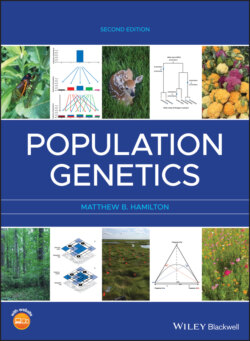Читать книгу Population Genetics - Matthew B. Hamilton - Страница 47
Mutation
ОглавлениеAlleles change from one form to another by the random process of mutation, which can either increase or decrease gametic disequilibrium. First consider the case of mutation producing a novel allele not found previously in the population. Since a new allele is present in the population as only a single copy, it is found only in association with the other alleles on the chromosome strand where it originated. Thus, a novel allele produced by mutation would initially increase gametic disequilibrium. Should the novel allele persist in the population and increase in frequency, then recombination will work to randomize the other alleles found with the novel allele and eventually dissipate the gametic disequilibrium. Mutation can also produce alleles identical to those currently present in a population. In that case, mutation can contribute to randomizing the combinations of alleles at different loci and thereby decrease levels of gametic disequilibrium. On the other hand, if the population is at gametic equilibrium mutation can create gametic disequilibrium by changing the frequencies of gamete haplotypes. However, it is important to recognize that mutation rates are often very low and the gamete frequency changes caused by mutation are inversely proportional to population size, so that mutation usually makes a modest contribution to overall levels of gametic disequilibrium. A simulation study showed that excluding any alleles at a frequency of less than 5–10% from estimates of D can eliminate most of the gametic disequilibrium attributable to recent mutations (Hudson 1985).
